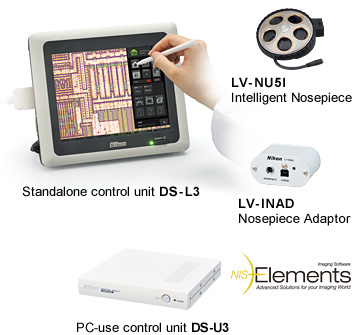
Motorized microscope with episcopic/diascopic illumination that enables control of objectives and light intensity from camera control unit and automatically detects observation method
A manual microscope with episcopic/diascopic illumination, which meets the various needs of observation, inspection, research, and analysis across a wide range of industrial fields. Higher NA and a longer working distance than ever before mean superior optical performance and efficient digital imaging.
Max. sample size: 150 x 150 mm
Key benefits
- Modularized microscope body applicable with various observations and tasks
- Newly developed CFI60-2 series provides the ultimate in long working distance levels and the most advanced chromatic aberration in a light weight body
- Easy digital imaging
Microscope Type
- Combined reflected/transmitted illumination models
- Manual type
Modularized microscope body applicable with various observations and tasks
Compatible with brightfield, darkfield, simple polarizing, DIC, epifluorescence and two-beam, interferometry observations. Furthermore, phase contrast and DIC observation with diascopic illumination are also possible.
It supports diverse and advanced research, analysis and inspection.
Compatible observation methods:
Compatible stages
- LV-S32 3×2 stage (Stroke: 75 x 50 mm with glass plate)
*Can be fitted with LV-S32SGH slide glass holder - LV-S64 6×4 stage (Stroke: 150 x 100 mm with glass plate)
- LV-SRP P revolving stage
- P-GS2 G stage 2 (Used with stage adapter LV-SAD)
- NIU-CSRR2 Ni-U right handle rotatable ceramic stage (Stroke: 78 x 54 mm)
- C-SR2S right handle stage (Stroke: 78 x 54 mm: Used with stage adapter LV-SAD)
Newly developed CFI60-2 series
Newly developed CFI60-2 series provides the ultimate in long working distance levels and the most advanced chromatic aberration in a light weight bodyCFI60-2 series offers higher NA and longer working distances than ever before.

Easy digital imaging

Through the combination of the Intelligent Nosepiece LV-NU5I and Nosepiece Adapter LV-INAD, information about the objective in use is detected and displayed in the monitor via the camera control unit. In addition, the information is automatically converted to appropriate calibration data when changing magnification.


